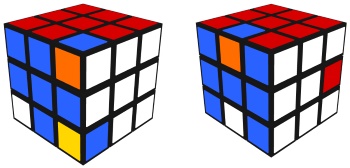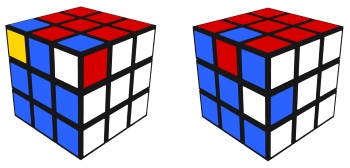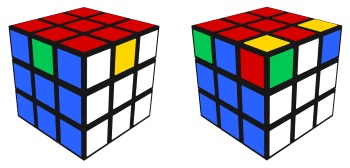Commutators And Conjugates
Commutators and conjugates are very simple ways of building sequences of moves that can, for example, permute pieces or orientate them.
Before getting started, you should know, at least, how to solve the cube by any method and maybe, have basic intuition in solving other cube variants.
Using these tools, you will be able to solve almost any cube you come across.
Commutators
Commutators are of the form:
X Y X’ Y’
where X,Y are sequences of moves and X’,Y’ are its inverse (the inverse of an algorithm are the moves you have to make to undo it: RUR’ is the inverse of RU’R’)
Three-cycle
A three-cycle is a rotation of the place of three pieces. They have to be obviously of the same kind. For instance, three corners or three edges.
You need to meet two conditions:
- Two of the three pieces must be in the same level. We will call this, the reference level.
- The third piece cannot be in the reference level.

Many people tend to place the reference level in the bottom face of the cube.
In this kind of commutator, X will be any moves you need to do to insert the piece which does not belong to the reference level in its objective place within it. This place has to be one of the two pieces you are involving in the three-cycle, obviously.
This algorithm cannot modify anything in the reference level (except for the change of one piece for another).
Y will be whatever move or moves you need, in order to put the piece in the reference level you have not yet exchanged, to that slot you just inserted a piece using algorithm X. Usually, Y is just a move or a double move and it’s really intuitive.
X’ and Y’ are simply the inverses of the algorithms you have just done.
Orientation swap
An orientation swap changes the orientaion of exactly two pieces and is also really easy.
Both pieces must be in the reference level so, unlike the three cycle, we don’t have a piece outside the reference layer to put into it.

What we will do with algorithm X is to take one of the pieces out and eventually place it back in its right orientation. Remember that you cannot modify anything else from the reference level.
Y is also the moves you need to place the piece you haven’t yet oriented to the place of the other.
Y’ and X’ are just the inverse algorithms of X and Y.
Pair swap
This kind of commutator swaps two pairs of two pieces. They are not very useful because in many cases you will just need a bunch of three-cycles to solve a big part of most of the cubes. Even though, they are very easy to work out and may be useful sometimes.
The only requirement you need to meet is that all four pieces have to be in the reference level.

Conjugates
Conjugates are based upon a ‘setup’ move A and its inverse A’ which you apply before and after any other algorithm. In general, A B A’, where B is also an algorithm.
A conjugate is the perfect tool you need if you have come up with a commutator. For example, if you know a commutator which cycles three pieces in the same layer, but the pieces you want to cycle aren’t in the same layer, you can use a conjugate.
Z X Y X’ Y’ Z’
They are very simple; you first do the moves you need to do to place the pieces you want to swap in the desired place or orientation. It can completely mess up your cube. Then, you execute the algorithm and afterwards, you undo the moves you did in the first place.
If you want to do a three-cycle and orientate the pieces, you can do both at the same time using a conjugate.